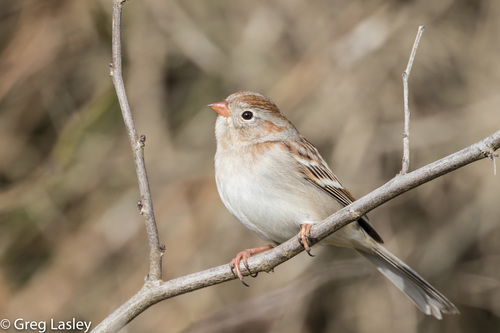
Field Sparrow
The Field Sparrow (Spizella pusilla) is a small, unassuming New World sparrow common throughout eastern and central North America. Often overlooked due to its subtle coloration, this species plays a vital role in controlling insect and seed populations within its grassland and shrubland habitats. It is not typically a bird of significant cultural importance but is appreciated by birdwatchers for its delicate song and the challenge it presents in identification amongst other sparrow species. Its presence is an indicator of healthy, open habitats.
12-15 cm
Length
18-21 cm
Wingspan
Least Concern
Conservation Status
Distribution
Breeds across eastern and central North America, from southern Canada (Ontario, Quebec, and the Maritime Provinces) south to the Gulf Coast states and northern Florida. Winters in the southeastern United States, extending slightly into northeastern Mexico. There is a resident population in the central and southern Great Plains.
Lifespan
The oldest known Field Sparrow lived at least 9 years and 2 months, based on recapture data from bird banding. Average lifespan is likely much shorter, around 2-3 years.
Field Sparrow's Habitat
Habitat Types
Old fields, Grasslands, Shrublands, Open woodlands, Roadsides with weedy vegetation
Climate Zones
Temperate, Subtropical
Adaptations
Their relatively long tails and short, rounded wings are adapted for maneuverability in dense, low vegetation. Their coloration provides camouflage in dry grassy environments.
Variations
Two subspecies are generally recognized: *Spizella pusilla pusilla* (eastern) and *Spizella pusilla arenacea* (western). The western subspecies is slightly paler and grayer.
Appearance
Breeding Plumage
Breeding plumage is brighter, with a more rufous crown and clearer facial markings. Non-breeding plumage is duller, with more streaking on the crown and a less distinct eye-ring.
Seasonal Feather Changes
See above. Molt occurs primarily after the breeding season.
Sex Based Plumage Differences
Minimal. Males may have slightly brighter plumage, but differences are subtle and require close observation.
Notable Features
Pinkish bill, White eye-ring, Rufous crown (often with faint streaking), Grayish face and underparts, Unstreaked breast
Diet and Feeding
Primary Foods
Seeds, Insects, Spiders, Small fruits
Foraging Behavior
Forages primarily on the ground, hopping and scratching among leaf litter and low vegetation. Will also glean insects from foliage.
Specializations
No highly specialized feeding adaptations. Their bill is conical and suited for cracking seeds, but also capable of capturing insects.
Seasonal Diet Variations
Diet shifts seasonally. Insects and other invertebrates are more important during the breeding season, providing protein for growing chicks. Seeds are the primary food source during the winter.
Behavior
Social Structure
Generally solitary or found in pairs during the breeding season. May form small flocks during the winter, often associating with other sparrow species.
Communication
A clear, accelerating song, often described as sounding like a bouncing ping-pong ball., Various chip and call notes.
Migration
Northern populations are migratory, while southern populations are largely resident. Migration is nocturnal.
Territorial or Group Behaviors
Males defend territories during the breeding season through song and chasing. Territories are relatively small.
Conservation
Threats
Habitat loss and degradation (due to agriculture, urbanization, and fire suppression), Pesticide use, Collisions with buildings and vehicles
Protection Programs
Conservation Reserve Program (CRP) in the United States (provides habitat on agricultural lands), Various state and local habitat restoration initiatives
Local National Laws
Migratory Bird Treaty Act
Population Trend
Declining in many areas, although the overall population is still considered relatively large.
Population Estimates
Partners in Flight estimates a global breeding population of 28 million.
Interesting Facts
Field Sparrows often build their nests directly on the ground.
This makes them vulnerable to predators and ground-nesting disturbances.
They can raise multiple broods in a single breeding season.
Especially in the southern parts of their range, where the breeding season is longer.
Field Sparrows are known for their distinctive song.
The song is a series of clear whistles that speed up and end in a trill, often likened to the sound of a bouncing ball.
Faqs about Field Sparrow
What do Field Sparrows eat?
They eat a mix of seeds and insects, with the proportion varying seasonally. They eat more insects during the breeding season and more seeds during the winter.
Where do Field Sparrows nest?
They nest on the ground or low in shrubs and small trees, often in old fields or grasslands.
Are Field Sparrows endangered?
No, they are currently listed as Least Concern by the IUCN, but their populations are declining in some areas due to habitat loss.
How can I attract Field Sparrows to my yard?
Provide a mix of native grasses, shrubs, and seed-bearing plants. Avoid using pesticides. A source of water can also be helpful.
Copyright @ Nature Style Limited. All Rights Reserved.
 English
English